One of the lasting effects of the recession that occurred at the
end of 2008 is that the working dynamics of many industries
have become more flexible yet unpredictable, and security is no
exception. However, the momentum of a recovering 2010 will
likely carry over into 2011, where exciting opportunities abound in
both emerging and mature markets.
One of the lasting effects of the recession that occurred at the end of 2008 is that the working dynamics of many industries have become more flexible yet unpredictable, and security is no exception. However, the momentum of a recovering 2010 will likely carry over into 2011, where exciting opportunities abound in both emerging and mature markets.
Business projections for market growth and focus, along with product development and range, underwent drastic changes in order to adjust to the volatile economic and financial conditions in 2009. By entering previously unexplored or underserved regions such as Latin America and the Middle East, some manufacturers found new opportunities in 2010 and enjoyed fruitful results. Now that the economy has rebounded in most parts of the world, what will 2011 look like for security?
Manufacturers seem equally optimistic about market demand, business prospects and available projects in 2011. IMS Research advises that the top three verticals to watch are city surveillance, transportation and utilities. All of these are forecasted to grow in excess of 15 percent compared to 2010.
In addition, projects in retail, education, health care and banking are already lined up in the business agenda for many manufacturers. “While uncertainty in the economy slowed capital spending in many areas, there has been an increased need for more effective security as economic difficulties have increased risks like internal and external theft,” said Peter Costa, VP and Business Leader of Global Protection, Honeywell Building Solutions.
Large-scale installations in these sectors often require multiple setup points, scattering across a wide campus or in individual branches or chain stores. “The profile of banking and finance, like the utility sector and managed service providers, typically has multiple locations and demands centralized management with a large degree of integration with other subsystems,” said Johan Lembre, CEO of Pacom Systems.
 Many manufacturers also have plans to proceed with projects for the government, transportation and public/city surveillance sectors. “We do foresee more larger-scale projects, such as in transportation, commencing in 2011,” said William Ku, Director of Brand Business at VIVOTEK. A research study published by Frost & Sullivan in the second half of 2010 indicates that rising terrorist threats enact as a key driver for mass transportation security implementations in the EU accession states, and the market is predicted to expand between 2010 and 2013 due to a competition for large infrastructure projects and life cycle replacements. IMS has also observed that spending in the transportation vertical — airports, ports and rail — is expected to remain high throughout 2011.
Many manufacturers also have plans to proceed with projects for the government, transportation and public/city surveillance sectors. “We do foresee more larger-scale projects, such as in transportation, commencing in 2011,” said William Ku, Director of Brand Business at VIVOTEK. A research study published by Frost & Sullivan in the second half of 2010 indicates that rising terrorist threats enact as a key driver for mass transportation security implementations in the EU accession states, and the market is predicted to expand between 2010 and 2013 due to a competition for large infrastructure projects and life cycle replacements. IMS has also observed that spending in the transportation vertical — airports, ports and rail — is expected to remain high throughout 2011.
“All countries were affected by the financial crisis, which in turn affected funding for infrastructure,” said Herve Fages, Global Marketing Director for Pelco (a Schneider Electric company). “However, government and largescale projects like airports, transportation and seaports remain as some of our targets.” Working in the government and public-infrastructure sectors has its own risks to note, however. The same Frost & Sullivan study indicates that the lack of security solutions tailored to mass transportation systems and the complex procurement pattern of available solutions have a possibility of hindering market potential for many. In addition, a third factor to consider is the balance between maintaining a strict security protocol and achieving passenger satisfaction.
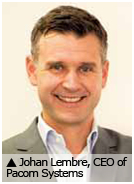 Similarly, Cisco Systems' recent sales and profit forecasts show cutbacks in government spending, which pose risks for companies relying on the sector for growth. For companies pursuing opportunities in mature markets, this might be a major concern.
Similarly, Cisco Systems' recent sales and profit forecasts show cutbacks in government spending, which pose risks for companies relying on the sector for growth. For companies pursuing opportunities in mature markets, this might be a major concern.
Various other manufacturers, such as Hikvision Digital Technology and Mirasys, will also focus on large recreational facilities like sports stadia, hotels and leisure spots in emerging markets.
Regional Markets
 In 2011, regions across the map — both emerging and mature — are promising more business opportunities. “In the Americas, there is still funding available for city surveillance in the U.S., and the two upcoming, major sporting events in Brazil will see many Latin American countries continue to invest in city surveillance to combat and reduce crime,” said Gary Wong, Senior Research Analyst for Video Surveillance and VCA, IMS Research. “In Asia, ‘Safe City' projects in China will be a significant driver of growth as new deployments continue to expand into other (Tier-3 and Tier-4) cities and existing deployments get upgraded (in specific verticals). In EMEA, growth will be driven by sizeable ‘Safe City' deployments and upgrades in Eastern Europe.”
In 2011, regions across the map — both emerging and mature — are promising more business opportunities. “In the Americas, there is still funding available for city surveillance in the U.S., and the two upcoming, major sporting events in Brazil will see many Latin American countries continue to invest in city surveillance to combat and reduce crime,” said Gary Wong, Senior Research Analyst for Video Surveillance and VCA, IMS Research. “In Asia, ‘Safe City' projects in China will be a significant driver of growth as new deployments continue to expand into other (Tier-3 and Tier-4) cities and existing deployments get upgraded (in specific verticals). In EMEA, growth will be driven by sizeable ‘Safe City' deployments and upgrades in Eastern Europe.”
The growth potential and level of demand in emerging markets reflect the driving force of local governments, and cost of operation is much lower particularly when compared to mature markets, said Tony Yang, International Marketing Director for Hikvision. Other costs, however, should be taken into account as well. These include import tariffs levied on finished electronic products and establishing local service centers among others. In addition, buyers in many emerging markets prefer cost-effective products, and some manufacturers inevitably compete on price alone in order to win bids and secure orders.
 As manufacturers take on projects in emerging markets less affected by the recession, such as Latin America, APAC and the Middle East, many are anticipating that business conditions in North America and Europe will return to prerecession levels. “The US market has been slow in recovery, but we are trying not to lose market share as we pursue emerging markets,” Fages said.
As manufacturers take on projects in emerging markets less affected by the recession, such as Latin America, APAC and the Middle East, many are anticipating that business conditions in North America and Europe will return to prerecession levels. “The US market has been slow in recovery, but we are trying not to lose market share as we pursue emerging markets,” Fages said.
To some solution providers, mature markets like Japan and Germany are served with high-end offerings. “As Japan and Germany are renowned for advanced technology requirements and product standards, the successful launches and acceptance of high-end products in these countries attest to the products' quality and reliability,” said Andy Lee, Marketing Manager of AVTech. Fortifying company and brand positions in mature markets is another approach to break into existing markets.
China and ASEAN Free Trade
 China, in particular, is regarded by many as a region with even more growth potential in 2011. “Urbanization in China is expected to continue at a rapid pace for the next two decades,” said Eng-Han Goh, VP of China Operations at ST Electronics (a Singapore Technologies Engineering company). “This will drive many associated segments.” Such verticals include government, transportation, intelligent building/ home management solutions, commercial and residential markets. Countless large-scale infrastructure projects are also near completion, requiring an unprecedented amount of low-voltage systems, including security and safety.
China, in particular, is regarded by many as a region with even more growth potential in 2011. “Urbanization in China is expected to continue at a rapid pace for the next two decades,” said Eng-Han Goh, VP of China Operations at ST Electronics (a Singapore Technologies Engineering company). “This will drive many associated segments.” Such verticals include government, transportation, intelligent building/ home management solutions, commercial and residential markets. Countless large-scale infrastructure projects are also near completion, requiring an unprecedented amount of low-voltage systems, including security and safety.
There is still room for growth for foreign system integrators (SIs) in the Chinese security market. “Foreign SIs will find that they need to offer new value propositions along the value chain, and provide creative and innovative solutions and unique product features,” Goh said.
To understand the market, SIs need to meander with care. “Without sufficient resources, the connections and the determination to break through, it'd be better to approach the Chinese market with even more caution,” said Patrick Lim, Director of Sales and Marketing for Ademco Far East. “It'd be hard to operate in the Chinese market without understanding the business culture and mindset first.”
 Setting up service centers and managed services is another way to be closer to local customers. “Companies that can offer China good technologies at competitive prices and software tools and management systems that will help improve efficiency, quality, productivity and sustainability will be able to accompany China in the urbanization process,” Goh said. The 12th five-year plan indicates that high-tech industries like green energy and biotechnology will be fast-tracked in terms of resource allocations.
Setting up service centers and managed services is another way to be closer to local customers. “Companies that can offer China good technologies at competitive prices and software tools and management systems that will help improve efficiency, quality, productivity and sustainability will be able to accompany China in the urbanization process,” Goh said. The 12th five-year plan indicates that high-tech industries like green energy and biotechnology will be fast-tracked in terms of resource allocations.
With the signing of the free-trade agreement (FTA) between China and ASEAN countries, many manufacturers have taken a wait-and-see stance to observe how the FTA policies pan out for China and its new partners on the business front. Some view the new trading alliance positively and anticipate that this new platform will enhance sales activities in the region. “Chinese manufacturers are now better positioned to enter the ASEAN market, and local channel players will be attracted to Chinese products more because of the low tariffs and improved trading procedures,” said Bruce Wu, Overseas Marketing Director for Dali Technology. Ku added that more companies might be interested in setting up warehouses in China to reduce the tax barrier.
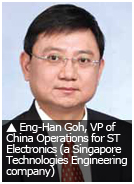 Fages believes that the FTA will assist international solution providers — with respect to cost and operational efficiency — with product promotions in ASEAN countries from their manufacturing and logistics facilities in China.
Fages believes that the FTA will assist international solution providers — with respect to cost and operational efficiency — with product promotions in ASEAN countries from their manufacturing and logistics facilities in China.
Polarized Requirements Another noticeable phenomenon in 2010 was the emergence of cost-effective but quality solutions. Industry heavyweights such as Axis Communications, Bosch, Honeywell, Panasonic, Sony and Pelco, who offered only high-end solutions in the past, have started to launch value or low-cost offerings. At the same time, more and more Asian manufacturers are devoting R&D efforts to developing high-end, tailored solutions to better satisfy intricate specifications from mature markets. So, what happened to the traditional mid-end market? “The key to success for manufacturers and installers should not be about ‘high-end' or ‘low-end,'” said Johnny Allia, VP and GM for EMEA, Honeywell Security. “It should be about providing innovative products and solutions that meet the present and unique security requirements and financial investment expectations of the end users, and that products are flexible and scalable to protect the business as it expands and diversifies.”
 For 2011, many hold the view that mid-end products, in comparison, will not be offered as much. “Mid-end products might have a market for Europe, excluding Germany, and North America, but the market is definitely becoming polarized,” Lee said. The decrease in quantities of mid-end offerings is an alarming proof.
For 2011, many hold the view that mid-end products, in comparison, will not be offered as much. “Mid-end products might have a market for Europe, excluding Germany, and North America, but the market is definitely becoming polarized,” Lee said. The decrease in quantities of mid-end offerings is an alarming proof.
The market has a tendency to shift either to the high-end grouping, where innovation and advanced functions are the central foci, or to the cost-effective side, where price is vital to a buyer's decision, said Craig Scott, CEO of OVii. “Of course there is room for further development in the mid range; however, with the way the security industry has evolved, it would be a great challenge.”
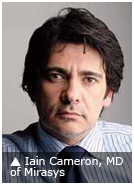 On the other hand, some are leaning toward continuing to offer only high-end products with innovative features and lasting quality. “More and more users are realizing that cost-effective products often do not carry advanced features and are unable to catch up with increasing user requirements as time goes on,” said Iain Cameron, MD of Mirasys. “Increasingly, high-end products will come back into play, as these products in the long run are better in overall performance.”
On the other hand, some are leaning toward continuing to offer only high-end products with innovative features and lasting quality. “More and more users are realizing that cost-effective products often do not carry advanced features and are unable to catch up with increasing user requirements as time goes on,” said Iain Cameron, MD of Mirasys. “Increasingly, high-end products will come back into play, as these products in the long run are better in overall performance.”
There are others who disagree with the high-end/low-end dichotomy and regard increasing competition as between proprietary and open systems. “Today's end users are demanding open solutions that don't lock them into proprietary protocols traditionally offered by manufacturers,” said Jumbi Edulbehram, VP of Business Development at Next Level Security Systems. “They want open, networked platforms that integrate traditionally separate subsystems together to increase security, reduce risk and enhance situational awareness.” It is believed that these open systems, based on industry standards, ensure interoperability in the field and long-term investment protection.
Demanding HD
For 2011, vendors unanimously agreed that with the rebound, there are still many projects to complete using either analog or networkenabled equipment. Growth potential for either technology looks promising.
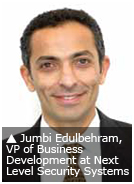 Globally, IMS forecasts that in 2011 the market for video surveillance equipment will grow by more than 10 percent on the previous year. With increasing adoption of networkenabled equipment, IMS believes that analog surveillance equipment sales will grow in low, single-digit percentages, while network video equipment sales will increase between 20 to 30 percent on the previous year. The education efforts done by organizations such as the PSIA and ONVIF and increasing preferences for open, remotely manageable platforms are most likely some of the drivers behind the growth for network video.
Globally, IMS forecasts that in 2011 the market for video surveillance equipment will grow by more than 10 percent on the previous year. With increasing adoption of networkenabled equipment, IMS believes that analog surveillance equipment sales will grow in low, single-digit percentages, while network video equipment sales will increase between 20 to 30 percent on the previous year. The education efforts done by organizations such as the PSIA and ONVIF and increasing preferences for open, remotely manageable platforms are most likely some of the drivers behind the growth for network video.
HDcctv technology is also coming into focus. Clearer market position and technology differentiation are estimated to emerge in the second half of 2011. “HDcctv cameras and DVRs are now on the road maps of most of the world's largest OEM/ODM manufacturers in China, Taiwan and Korea for the first quarter in 2011,” Scott said.
In simple terms, some manufacturers feel that network cameras will continue to be widely used in the education, health care and large infrastructure markets; HDcctv will take up the mid- to high-range market in retail and banking; and analog products will continue to serve the general public in smaller-scale projects.
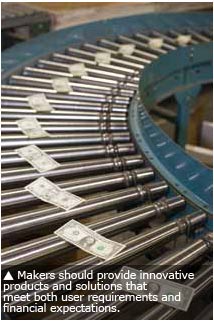 Regardless of analog, HDcctv, hybrid or IP, all manufacturers predict that HD will become mainstream in 2011. HD technology was introduced at large in 2010, and widespread acknowledgement and acceptance of this technology have paved way for its further development and employment in 2011. Most IP incumbents have already developed new product lines based on HD technology to satisfy growing demands from end users for ultimate clarity in video footage. “Speaking from a technology viewpoint, network video is the revolution of yesterday, and it's already there in the market. Now, we're trying to push more HD infrastructure into the market and are ready for the next challenge,” Fages said.
Regardless of analog, HDcctv, hybrid or IP, all manufacturers predict that HD will become mainstream in 2011. HD technology was introduced at large in 2010, and widespread acknowledgement and acceptance of this technology have paved way for its further development and employment in 2011. Most IP incumbents have already developed new product lines based on HD technology to satisfy growing demands from end users for ultimate clarity in video footage. “Speaking from a technology viewpoint, network video is the revolution of yesterday, and it's already there in the market. Now, we're trying to push more HD infrastructure into the market and are ready for the next challenge,” Fages said.
New Opportunities
The market saw introduction of various new applications in 2009 and 2010, such as more refined VCA, software as a service (SaaS) and managed video as a service (MVaaS). Over the past year, adoption of these new features into products has been slow, and some feel that recession was just one of the reasons. “New applications need time to mature before they can be utilized for day-to-day operations, as their performance capability and real-life functionality are not on par with one another so far,” Scott said. This difference between expectations and reality poses as the main stumbling block for solution providers to further develop these new technologies.
However, they might fare better in 2011, as some predict that more investments will be poured into developing and maturing these new technologies. “The potential for SaaS and MVaaS should grow as they do have advantages by nature of their platforms,” said Daniel Ong, VP of Certis Technology International, Certis Cisco Security. “These advantages include lower cost, quicker and better deployments, more hassle-free support and a smaller IT footprint.” Security implications and general costs of bandwidth and maintenance will be monitored by end users, and more IT-savvy SIs are needed to actively market related services. “Over time, as they mature in features and functionality, SaaS and MVaaS will evolve to be a more appealing alternative to customers,” Ong said.
 For others, the game already kicked off. “Our partners are using SaaS as a platform to generate recurring revenues from their customers, predominantly through the provision of managed access control,” Lembre said.
For others, the game already kicked off. “Our partners are using SaaS as a platform to generate recurring revenues from their customers, predominantly through the provision of managed access control,” Lembre said.
Sc ale New Heights With the dark cloud of the recession clearly behind, all solution providers have high hopes for 2011. Major projects previously suspended will resume, and projects of all sizes will be started or completed. Aside from products, tailored features, customer service and support centers are becoming increasingly demanded. By interacting with end users and knowing their needs better, companies will be able to develop and launch better “destructive innovation.” Despite the turbulence and the rapid adjustments in the market and industry, 2011 is shaping up to be a year of exceptional growth and development for all.
*Read the 2011 market forecast at <Scale New Heights>